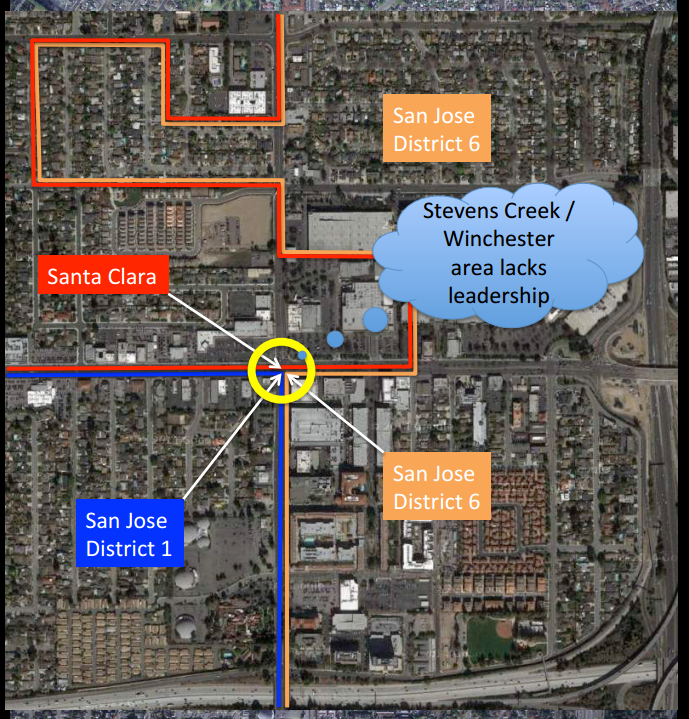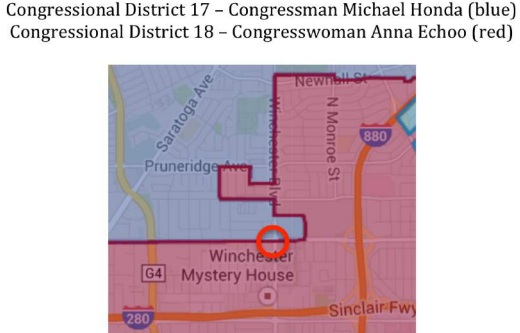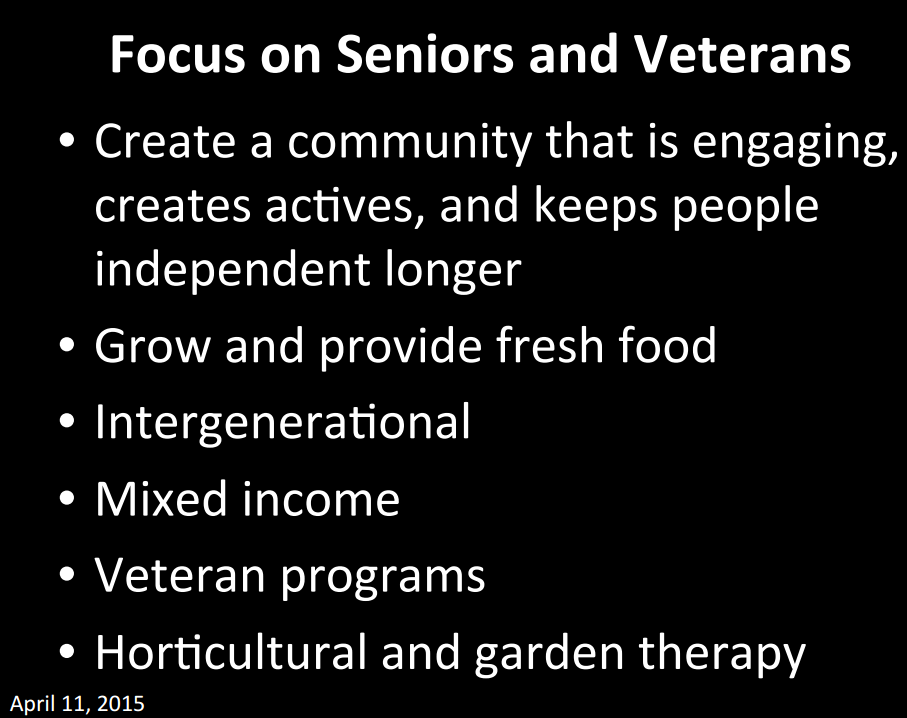Another potential land development proposal in Santa Clara gives me a great example of the disjointed disconnected non-integrated planning process I discussed the other day. That is, as a long-time resident of Silicon Valley (over 25 years) I see that much of the sprawlitis-causing-traffic-congestion that’s now plaguing our area is sourced in planning decisions which are overly silo’d and not integrated with other developments or mass transit systems. The other day I focused on a “road diet” planned for Tasman Blvd, and a nearby huge shopping/hotel/residential/business development. Today I want to focus on the opposite side of Santa Clara, where a 6 acre parcel across the street from Valley Fair Shopping Center, that’s amazingly undeveloped, is about to receive approval for development.
An extremely interesting proposal![]() has been made that would be a tiny smidgeon of an effort towards better integration of the city-scape we live in, by building an “Agrihood” near one of the busiest intersections around. I met the people behind that proposal the other night and think they’ve crafted a wonderful idea.
has been made that would be a tiny smidgeon of an effort towards better integration of the city-scape we live in, by building an “Agrihood” near one of the busiest intersections around. I met the people behind that proposal the other night and think they’ve crafted a wonderful idea.
The idea (see rendering above) is to build an Agrihood or an agriculturally oriented neighborhood, that would be highrise apartment buildings for senior citizens, with a couple acres of urban farming on the ground, and shops at the ground floor. Perhaps some of the housing could be set aside for Veterans? There is a Veterans Administration building immediately adjacent to the plot. Additional elements design in some integration with neighboring infrastructure, such as a pedestrian overpass connecting it with the Mall across the street, and the potential to integrate with both the VA building and the little strip mall next door.
This is the context within which the development sits.
The 6 acre parcel is in the upper-left quadrant and has a kind of tannish color. Next to it is a few rows of boxes that is a housing complex recently built on the other half of this parcel. The land in question had been, a few decades ago, an agricultural research outpost of UC Davis way back when all this land was orchards and farms and everyone called it The Valley of Hearts Delight. I keep thinking about that history and wonder at what has been lost in the mad rush to build Silicon Valley on the bones of the Valley of Hearts Delight.
Governments being what they are, it took a long time for that agricultural research outpost to be declared “Surplus Land” allowing it to be disposed of. The City of Santa Clara bought the land – and is seeking to develop it under constraints about being used for public benefit. In the intervening time they allowed Summerhill Homes to develop a housing complex, which became an exercise of seeing how many homes could be crammed into a given area of land. It felt bleak to me. What’s left is the 6 acres shown here.
The City of Santa Clara made a call for proposals with the RFP’s having all been filed by April 30. The city is now in the process of evaluating the RFP’s, one of which is described on the site linked above. At the bottom I’ll give information on contacting the city to lend ones support behind the proposal of your choosing.
The upper-right quadrant is the Valley Fair Shopping Center. It’s one of the venerable old shopping malls in Silicon Valley, and they’ve begun a major redevelopment of the shopping center with a major expansion due by 2017. There’s close to a billion dollars of business transacted there, which should balloon to over a billion dollars a year once the expansion is done.
Across from that is the Santana Row shopping center owned by Federal Realty Trust, and across from Santana Row is a former movie theater complex that’s been shut down, which FRT has bought, and is planning to develop. FRT is building two massive Class A Office complexes on the site which should become the corporate headquarters for some tech giants in a couple years.
In short – there’s a massive amount of development activity going on right now, already been approved, within the territory shown on this map.
The disturbing thing is the development activity isn’t being coupled with any thought to mass transit improvements. These developments will clearly increase the number of human beings moving through the vicinity, and unless there’s mass transit upgrades those humans are going to choose to travel in and out of this area by car. That would clearly cause more traffic burden in a locale that’s already got a lot of cars wandering around.
This is a variation of the same map – showing political boundaries – and demonstrating a significant problem here. San Jose and Santa Clara are intertwined at this location, and several political boundaries meet at the intersection of Winchester and Stevens Creek.
And the same boundary problems exist for the State Assembly and Congressional district boundaries. The blue area is Santa Clara, the red area is San Jose.
It means part the Valley Fair shopping center is partly in San Jose, partly in Santa Clara, and in some stores the city to which your sales tax goes depends on which register that’s used because the city border runs right through the store.
The other effect is the area doesn’t receive integrated attention by combined political and bureaucratic oversight. Instead, the situation is rife with the potential for political and bureaucratic fighting. Not that I know such fighting is going on. It’s obvious that given these boundaries, and the massive economic activity going on here, that means and motive exist to incite such fighting.
Let’s get back to the proposal now.
The win6village.org website has a lot of details, and even more is in the RFP they filed with the city. The people making this proposal ask us to consider these guiding principles:
We could cry about all the development happening on the neighboring parcels – it’s not sustainable – no transit – Valley Fair is just another shopping mall – etc etc – but the opportunity exists for this little 6 acre parcel to possibly set an example for the owners of the neighboring parcels, possibly influencing what they finally build. And in any case, forming a vibrant integrated urban environment means integrating everything around us into an organic whole. These are good principles to that end.
The people making this proposal have worked on it for 18+ months, putting their own money into a project that won’t directly benefit them. Instead, they seem honestly focused on pushing for a livable city structure. What we have today in Silicon Valley is anything but livable, thanks to the designed-in sprawl thanks to earlier urban design policies across the region.
These are benefits they hope to achieve with the project.
The urban farming portion of the site would be managed by a local urban farming organization that’s already in operation. There may be opportunity for residents to do some of the work, but the primary benefit is fresh food grown directly on the site. There are existing soil tests of the site claiming soil quality to meet Residential Zone standards, the highest standard, meaning there’s no lingering chemical contamination, and it’s highly suitable for farming. There is probably some rehabilitation to do, to rebuild organic matter in the soil because the site has been left fallow for a long time and is currently home to a rich crop of weeds.
There are many great ideas on the website and in the RFP such as:
- Limiting parking to encourage car-free living
- Locating car sharing services on the site to help w/ car-free living
- Rooftop solar panels, or rooftop gardening
- Pedestrian overpasses on these streets – crossing Stevens Creek isn’t exactly easy or safe for pedestrians
- Using Aquaponics in the urban ag section to increase on-site food production – they believe the site could produce more food than required by the residents, and one of the shops could be a farmers market
There is of course more going on in the area than this 6 acre parcel. The organizers of this proposal have other ideas in mind that would create more pedestrian-friendly infrastructure, such as the pedestrian overpasses.
For example, the Valley Transit Agency (VTA) is pushing for Bus Rapid Transit (BRT) on El Camino Real. While that’s great, it doesn’t help the San Carlos Ave / Stevens Creek Blvd avenue. This road starts in Downtown San Jose as West San Carlos, becomes Stevens Creek Blvd at some point, and extends 10-15 miles all the way to De Anza Community College in Cupertino. They want BRT service along that road. Current transit in the vicinity is the #60 and #23 bus lines, and an Express companion to the #23.
Another far-out idea is to build platforms over I-280 for additional buildings and perhaps pedestrian connections across that highway.
As for contact info for the Santa Clara City Council …
http://santaclaraca.gov/index.aspx?page=395![]() – That lists the Mayor and City Council members. The e-mail address for all these fine people is: MayorandCouncil –at– santaclaraca.gov
– That lists the Mayor and City Council members. The e-mail address for all these fine people is: MayorandCouncil –at– santaclaraca.gov
At http://www.win6village.org/commuiyt-meeting-files.html![]() is a link to a sample letter which could be sent in support of the proposal described above.
is a link to a sample letter which could be sent in support of the proposal described above.
You can follow the project at https://www.facebook.com/Win6Village![]() and https://Twitter.com/win6village
and https://Twitter.com/win6village![]()
- Is there enough Grid Capacity for Hydrogen Fuel Cell or Battery Electric cars? - April 23, 2023
- Is Tesla finagling to grab federal NEVI dollars for Supercharger network? - November 15, 2022
- Tesla announces the North American Charging Standard charging connector - November 11, 2022
- Lightning Motorcycles adopts Silicon battery, 5 minute charge time gives 135 miles range - November 9, 2022
- Tesla Autopilot under US Dept of Transportation scrutiny - June 13, 2022
- Spectacular CNG bus fire misrepresented as EV bus fire - April 21, 2022
- Moldova, Ukraine, Georgia, Russia, and the European Energy Crisis - December 21, 2021
- Li-Bridge leading the USA across lithium battery chasm - October 29, 2021
- USA increasing domestic lithium battery research and manufacturing - October 28, 2021
- Electrify America building USA/Canada-wide EV charging network - October 27, 2021


















